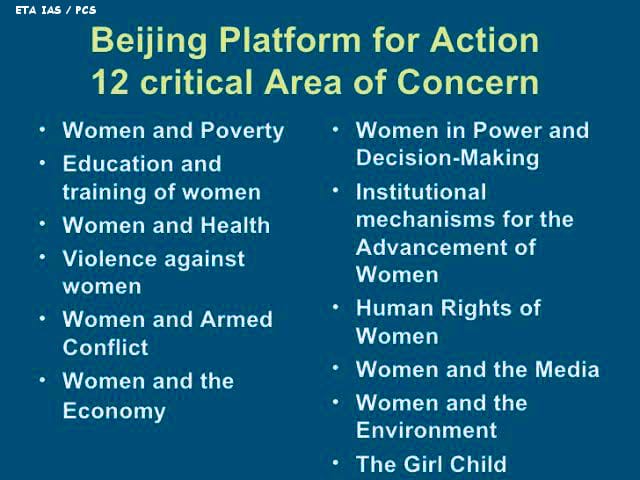CONTEXT: As India progresses on its path to achieving gender equality, the Beijing Platform for Action continues to serve as an essential framework.
About the Beijing Platform for Action
Beijing Declaration: A resolution adopted by the United Nations (UN) at the conclusion of the Fourth World Conference on Women in September 1995.
Purpose: The resolution was designed to promote a set of principles aimed at achieving gender equality between men and women.
Key Areas of Focus: The platform covers 12 critical issues and areas for action, seen as the main barriers to empowering women.

India’s Progress in Promoting Women’s Rights
Maternal and Reproductive Health:
Institutional Deliveries: The rate has risen to 95% due to programs like the PM Surakshit Matritva Abhiyan and PM Matru Vandana Yojana.
Maternal Mortality Rate (MMR): The MMR has dropped from 130 in 2014 to 97 in 2020 per 100,000 live births, according to Sample Registration System data.
Modern Contraceptive Use: 56.5% of married women now use modern contraceptives, enhancing reproductive autonomy.
Women’s Access to Healthcare:
- Ayushman Bharat Pradhan Mantri Jan Arogya Yojana: The world’s largest government-funded healthcare initiative has provided millions of women with free medical treatment.
Education and Skill Development:
Improvement in Child Sex Ratio: Achieved through initiatives like Beti Bachao Beti Padhao (BBBP).
Higher Retention Rates in Education: The National Education Policy 2020 has integrated education with skills training.
STEM Opportunities for Women: Efforts have been made to encourage women’s participation in Science, Technology, Engineering, and Mathematics (STEM).
Menstrual Hygiene Support: Improved sanitation has reduced school absenteeism among adolescent girls.
Women’s Economic Empowerment:
Financial Inclusion through Self-Help Groups (SHGs): The National Rural and Urban Livelihood Missions have connected 100 million women to financial networks.
Deendayal Antyodaya Yojana – National Rural Livelihood Mission: Facilitated credit and livelihood opportunities for women.
Digital Financial Inclusion:
Unified Payments Interface (UPI): Significantly increased women’s participation in digital savings and investments.
Pradhan Mantri Gramin Digital Saksharta Abhiyan: Empowered 35 million rural women with digital literacy skills.
Gender-Responsive Budgeting:
Increased Allocation: The allocation for gender-specific initiatives within the national budget has risen from 6.8% in fiscal year 2024-25 to 8.8% in 2025-26.
Total Funding: A total of $55.2 billion has been designated for programs aimed at addressing gender issues.
Women in Leadership:
New Generation of Leaders: Young women are increasingly taking leadership roles in sectors like climate action, digital entrepreneurship, and governance.
Supportive Projects: Initiatives such as the Gender Advancement for Transforming Institutions (GATI) and the G20 TechEquity Platform exemplify this shift, helping thousands of young women in STEM and emerging technologies.
Political Representation:
Women’s Reservation Act: Ensures women hold 33% of seats in legislative bodies, promoting gender balance in decision-making.
Local Governance Empowerment: Local governance initiatives have empowered 1.5 million women leaders, creating the world’s largest cohort of women in political leadership.
Actions Against Gender-Based Violence:
Ongoing Challenge: Despite legal protections, gender-based violence remains a persistent issue.
Government Initiatives:
- One Stop Centres: 770 centres have been established to provide comprehensive support, including medical, legal, and psychological services to survivors.
- Bharatiya Nyaya Sanhita 2023: Enacted in July 2024, it strengthens legal protections for women.
- Odisha Blockchain Initiative: Ensures prompt and confidential assistance for survivors of violence.
- Gender-Responsive Policing: A collaboration between the Rajasthan Police Academy and the UN Population Fund has built trust and improved access to justice for survivors.
Way Forward
30th Anniversary of the Beijing Declaration: Marks a pivotal moment in recognizing that gender equality is a global imperative, reaffirming the commitment to women’s rights and empowerment.
India’s Approach: Backed by strong government leadership, global partnerships, and policy innovation, India is emerging as a model for inclusive and sustainable development that prioritizes gender equality.
Key Future Priorities:
Strengthening Collaborations: Continue building and reinforcing partnerships with local and global stakeholders to amplify the impact of gender equality initiatives.
Investing in Young Women’s Leadership: Focus on empowering young women in governance and the economy, ensuring that they are well-equipped to lead in various sectors.
Addressing Systemic Barriers: Work on eliminating systemic barriers such as the digital gender divide, safety concerns, and economic dependency that hinder women’s full participation in society.
Women-Led Development: By reinforcing and prioritizing women-led development, India continues to set a global benchmark for gender equality and social transformation.
